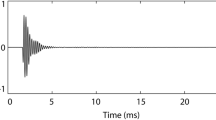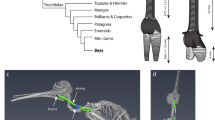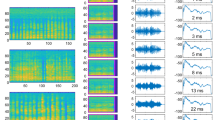Abstract
Replying to: U. Wittrock Nature 466, 10.1038/nature09156 (2010)
Wittrock suggests that a stylohyal–tympanic connection in laryngeally echolocating bats as the one described in our study1could transmit laryngeal vibrations to both ears2. This could represent a ‘local oscillator’, forming part of a heterodyne-like detection system for precise target detection and localization. The essence of this exciting idea is that the externally transmitted echo (signal of interest) received by the ears would be mixed (multiplied) with an internally transmitted copy of the outgoing biosonar sound (reference signal) via vibrations of the stylohyal. The multiplicative mixing would generate two new signals—one at the sum and the other at the difference of the original inputs—and after low-pass filtering the remaining components would include a difference frequency signal that varied in its rate of amplitude modulation (AM).https://www.nature.com/articles/nature09156
Similar content being viewed by others
Main
Wittrock’s proposal is a logical extension of the first function that we suggested for the stylohyal–tympanic connection in bats1. A heterodyne-like mechanism may be possible because AM rates up to a few kilohertz could be encoded in the responses of primary auditory afferent neurons. This mechanism applies most obviously to high duty cycle echolocating bats—species that regularly exploit Doppler-shifted echoes (for example Rhinolophidae, Hipposideridae, Pteronotus parnellii)—but its use is not precluded in low duty cycle bats that emit calls containing more than a single (narrowband) frequency. Indeed, a heterodyning mechanism may help to explain why so many bats emit downward hyperbolic frequency-modulated (FM) sweeps. In these signals, such linear period modulated chirps emphasize (elongate) the duration of the lowest frequencies in the FM sweep.
One difficulty with the heterodyning hypothesis lies in identifying the nonlinear biological mechanism for multiplying bone-conducted vibrations with airborne-conducted vibrations. Another potential difficulty is the difference in velocity between the speed of sound in bone (∼3,500 m s−1) and the speed of sound in air (∼344 m s−1), which could result in a latency difference at the cochlea. For the stylohyal–tympanic bony connection to function as part of a heterodyning system, either (1) there is a mechanism to delay vibrations transmitted along the hyoid apparatus, and/or (2) the tympanic must continue to ‘ring’ after the outgoing biosonar vocalization has ended so that the signal can be mixed with later returning echoes. Intervening elastic elements within the hyoid chain may generate the delay necessary for possibility (1) but could also introduce significant damping of bone-conducted vibrations. Possibilities (1) and (2) remain to be investigated experimentally, but clearly represent productive areas for future research.
References
Veselka, N. et al. A bony connection signals laryngeal echolocation in bats. Nature 463, 939–942 (2010)
Wittrock, U. Laryngeally echolocating bats. Nature 466 10.1038/nature09156 (2010)
Author information
Authors and Affiliations
Contributions
P.A.F., D.D.M. and M.B.F. wrote the response in consultation with the other authors (N.V., D.W.H., J.L.E., R.K.C., M.J.M. and K.L.B.).
Ethics declarations
Competing interests
Competing interest: declared none.
Rights and permissions
About this article
Cite this article
Veselka, N., McErlain, D., Holdsworth, D. et al. Veselka et al. reply. Nature 466, E7 (2010). https://doi.org/10.1038/nature09157
Issue Date:
DOI: https://doi.org/10.1038/nature09157
This article is cited by
-
Multi-frequency sound production and mixing in graphene
Scientific Reports (2017)
Comments
By submitting a comment you agree to abide by our Terms and Community Guidelines. If you find something abusive or that does not comply with our terms or guidelines please flag it as inappropriate.



